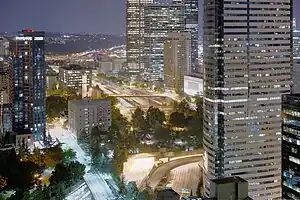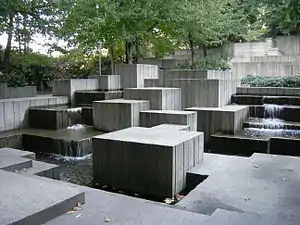Freeway Park
Freeway Park, officially known as Jim Ellis Freeway Park, is an urban park in Seattle, Washington, United States, connecting the city's downtown to the Washington State Convention Center and First Hill. The park sits atop a section of Interstate 5 and a large city-owned parking lot; 8th Avenue also bridges over the park. An unusual mixture of brutalist architecture and greenery, the 5.2-acre (21,000 m2) park, designed by Lawrence Halprin's office under the supervision of Angela Danadjieva, opened to the public on July 4, 1976, at a cost of $23.5 million.[5] A later addition to the park opened in 1982 winds several blocks up First Hill, with a staircase and wheelchair ramp.[6]
| Freeway Park | |
|---|---|
 Aerial view of Freeway Park at night | |
| Type | Urban park |
| Location |
|
| Coordinates | 47°36′35″N 122°19′52″W |
| Area | 5.2 acres (2.1 ha; 0.0081 sq mi; 0.021 km2)[1] |
| Opened | July 4, 1976 |
| Owned by | Seattle Parks and Recreation |
| Operated by | Freeway Park Association |
| Open | 6:00 a.m. to 10:00 p.m.[2] |
| Public transit access | |
| Architect | Lawrence Halprin, Angela Danadjieva |
| Architectural style | Brutalism |
| NRHP reference No. | 100004789 |
| Significant dates | |
| Added to NRHP | December 19, 2019[3] |
| Designated WHR | October 25, 2019[4] |
The park is also a cultural landscape and a precedent setting park that, according to The Cultural Landscape Foundation, helped define a new land-use typology for American cities.[7] It was listed on the National Register of Historic Places on December 19, 2019, having been listed on the Washington Heritage Register in a unanimous vote on October 25.[3][4] In May 2022 it also gained official landmark status from the City of Seattle.[8]
The park's unique architecture has made it famous among parkour enthusiasts. The World Freerunning and Parkour Federation listed Freeway Park second on its list of the seven best parkour locations in the world.[9]
History
A series of crimes, notably a January 18, 2002 murder, briefly gave the park a reputation as a haven for crime and led to calls for a radical redesign.[10] Many at first attributed the dangers to the design of the park. A neighborhood group formed under the name Freeway Park Neighborhood Association (FPNA) collaborated with the city's parks and recreation department to produce an "activation plan" for the park, published in 2005 as "A New Vision for Freeway Park". The report concluded that the park's problems could be remedied by numerous small changes: increased security patrols, better lighting, pruning back of certain plants, and above all increased use, both in terms of organized events and simply encouraging more convention center visitors to use the park.[11] The strategy, only partly implemented as of summer 2005, seems to be succeeding: according to David Brewster of the FPNA, crime in the park is down 90% compared to that of 2002.[12][13] The park was renovated in 2008 and renamed to honor civic leader Jim Ellis.[14]
Gallery
 Brutalist fountain, Freeway Park, circa 1970s.
Brutalist fountain, Freeway Park, circa 1970s. The park winds its way down First Hill, offering both a staircase and wheelchair-accessible ramps.
The park winds its way down First Hill, offering both a staircase and wheelchair-accessible ramps. Brutalist fountain, Freeway Park.
Brutalist fountain, Freeway Park.




References
- Annual Report 2019 (Report). Freeway Park Association. April 13, 2020. Retrieved October 25, 2021 – via Issuu.
- "Freeway Park - Seattle Parks and Recreation". Seattle.gov. City of Seattle. Retrieved October 25, 2021.
- "Weekly List 20191220 - National Register of Historic Places". National Park Service. United States Department of the Interior. December 20, 2019. Retrieved October 25, 2021.
- Reiner-Roth, Shane (November 5, 2019). "Seattle's Brutalist Freeway Park is reviewed for National Register and approved for renovation". The Architect's Newspaper. Retrieved October 25, 2021.
- Beckner, Chrisanne (September 2019). "National Register of Historic Places Registration Form: Freeway Park" (PDF). United States Department of the Interior. Archived from the original on October 25, 2021. Retrieved October 25, 2021.
- Easton, Valerie (July 27, 2008). "In the concrete jungle, Freeway Park will offer respite once again". The Seattle Times. Archived from the original on June 16, 2018. Retrieved October 27, 2019.
- Maryman, Brice; Birkholz, Liz (2005). "Freeway Park/Past, Present and Future?". The Cultural Landscape Foundation. Archived from the original on February 28, 2009. Retrieved May 31, 2009.
- "Freeway Park in downtown Seattle declared city landmark". KIRO-7. May 20, 2022. Retrieved July 8, 2022.
- Parham, Sam (February 18, 2020). "The 7 Best Parkour Locations in the World". World Freerunning and Parkour Federation. Retrieved February 21, 2021.
- Mudede, Charles (August 22, 2002). "Topography of Terror". The Stranger. Retrieved May 31, 2009.
- A New Vision for Freeway Park (PDF) (Report). Project for Public Spaces. January 2005. Archived from the original (PDF) on February 18, 2007. Retrieved September 3, 2005.
- Brewster, David (August 16, 2005). "Freeway Park". Weekday (Interview). Interviewed by Steve Scher. Seattle, Washington: KUOW. Archived from the original on August 12, 2009. Retrieved May 31, 2009.
- Iwasaki, John (July 19, 2005). "Improvements bringing people back to Freeway Park". Seattle Post-Intelligencer. Retrieved May 31, 2009.
- Gilmore, Susan (September 3, 2008). "Group pushing to rename Freeway Park". The Seattle Times. p. B4. Retrieved October 27, 2019.
Further reading
- Tate, Alan (2001). Great City Parks. London: Spon Press. ISBN 0-419-24420-4.